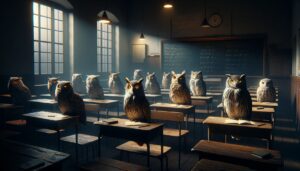GLOWING CONCERNS
Wildlife in the LED Era
- Owner of Knockout Lighting Design Inc.
The Unseen Consequences of Light
In recent years, LED (Light Emitting Diode) lighting has revolutionized how we illuminate our cities and homes. Celebrated for its energy efficiency and longevity, LED lighting has been widely adopted as a greener alternative to traditional incandescent and fluorescent lights. However, this shift, while beneficial in terms of energy conservation and cost-effectiveness, has raised new environmental concerns, particularly regarding its influence on wildlife.
While the environmental benefits of LED lighting are well-documented, its ecological effects, especially on nocturnal wildlife, are less understood. Research have begun to uncover how the altered lightscapes due to LED proliferation are affecting various animal species, from the smallest insects to larger mammals. This article explores the effects of LED lighting on specific wildlife such as raccoons, foxes, turtles, bats, and aardvarks, exploring the ripple effects on ecosystems and what can be done to mitigate these influences.
Understanding LED Technology
LED lights work by passing an electrical current through a microchip, illuminating the tiny light sources we see in our LED luminaires. Unlike traditional light sources, they can emit light in specific color spectrums and with greater intensity. This technological advancement has led to widespread adoption, given its cost-effectiveness and lower energy consumption. However, the very characteristics that make LEDs efficient also contribute to their influence on wildlife.
LEDs typically emit a higher proportion of blue light, compared to other lighting technologies. This shift in the color spectrum is significant for wildlife, as many species are sensitive to specific light wavelengths. Blue light, with its shorter wavelength, is more likely to effect nocturnal animals’ natural behaviors, as it mimics the spectral qualities of natural daylight more closely than the redder, warmer light of traditional lamps.

Effects on Different Wildlife Species
Raccoons and Urban Wildlife…
In urban areas, the increased use of LED street lighting has been shown to affect nocturnal animals like raccoons. Raccoons, which are adaptive and often thrive in urban settings, experience changes in their natural foraging behaviors due to increased night-time brightness. Studies have indicated that this can lead to altered feeding patterns and increased vulnerability to predators or road accidents.
Foxes and Predatory Behaviors…
Similarly, for predators like foxes, the increased night-time visibility can alter their hunting patterns. While this might seem beneficial for the foxes, it disrupts the natural balance between predators and prey. This disruption can have cascading effects on local ecosystems, as artificial light at night can significantly alter the predator-prey dynamic.
Necessity for Dark Beaches…
One of the most well-documented effects of LED lighting is on sea turtles. Beachfront lighting, including LEDs, can disorient turtle hatchlings, leading them away from the ocean. According to research by the Florida Fish and Wildlife Conservation Commission artificial lighting causes thousands of hatchling deaths each year by leading them inland instead of towards the sea.
This phenomenon underscores the need for “dark beaches” during the sea turtle nesting season. Organizations like the Sea Turtle Conservancy have been advocating for turtle-friendly lighting practices, such as using low-intensity, long-wavelength lights (e.g., amber or red LEDs) that are less disruptive for turtles.

Bats and Altered Food Sources…
For nocturnal creatures like bats, LED lighting’s influence is indirect but significant. Bats feed on insects, many of which are attracted to LED lights. This artificial aggregation of insects can lead to localized food shortages for bats, effecting their hunting efficiency and survival. Studies, such as one conducted by the UK’s Bat Conservation Trust, have highlighted how street lighting can alter the ecological balance by affecting insectivorous bat species.
These shifts can lead to broader ecological imbalances. For example, if bats, which are natural pest controllers, are unable to fulfill their ecological roles, there could be an increase in pest populations, leading to issues in agricultural and natural ecosystems.
Aardvarks: An Indicator Species…
Aardvarks, though less commonly discussed, offer a unique perspective on the influence of LED lighting. These nocturnal animals are crucial to maintaining the ecological balance in their habitats. The concern about increased nighttime illumination affecting aardvarks’ foraging habits and sheltering behavior is indeed a significant ecological issue. Aardvarks are nocturnal mammals and they are well-adapted to life in the dark. Their diet mainly consists of ants and termites, which they forage for at night.
The case of aardvarks illustrates that the ecological consequences of LED lighting extend beyond the most commonly studied species. These changes can ripple through entire ecosystems, affecting biodiversity and the health of various habitats. The decline in a species like the aardvark can have unforeseen effects, given their role in aerating soil and controlling insect populations.
The Interconnectedness of Changes
The introduction of LED lighting has a cascading effect across ecosystems. Changes in one species’ behavior or population dynamics, triggered by altered lighting conditions, can lead to a series of reactions throughout the food chain. This interconnectedness means that the effects of LEDs goes beyond individual species, affecting entire ecological communities.
The long-term ecological effects are still being studied, but it’s clear that the influence of LED lighting is profound. As per a report by the International Dark-Sky Association, the disruption of natural light cycles can affect everything from plant flowering times to animal migration patterns, altering the delicate balance of ecosystems.
Mitigation Strategies and Future Directions
To mitigate the impact on wildlife, several strategies can be employed. For instance, using LEDs with warmer color temperatures or incorporating motion sensors to reduce unnecessary lighting can significantly lessen ecological disruptions. The Florida Fish and Wildlife Conservation Commission, for example, provides guidelines for wildlife-friendly lighting choices.

On a broader scale, policy initiatives and community involvement are crucial. Implementing lighting regulations, as seen in some coastal areas for sea turtle protection, can help mitigate negative effects. Public awareness campaigns and community involvement in adopting wildlife-friendly lighting practices also play a key role in conservation efforts.
Conclusion
While LED lighting offers significant benefits in terms of energy efficiency and cost savings, it’s crucial to balance these advantages with the needs of our natural environment. Understanding and mitigating the impact of LED lighting on wildlife is essential in preserving biodiversity and maintaining healthy ecosystems. Continued research, policy development, and public education are necessary to ensure that the transition to energy-efficient lighting doesn’t come at the expense of our planet’s wildlife. By taking a holistic approach considering both technological advancement and ecological conservation, we can create a sustainable and wildlife-friendly future.
How much does your lighting cost?
Enter details about your lighting system to estimate the cost.
Disclaimer: This calculator provides estimates only and is not a substitute for professional advice. Consult a qualified professional for detailed lighting planning and compliance with standards.
